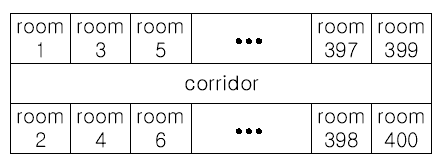HDU 1050 Moving Tables
来源:互联网 发布:无地自容 知乎 编辑:程序博客网 时间:2024/05/21 17:38
题目链接:http://acm.hdu.edu.cn/showproblem.php?pid=1050
Moving Tables
Time Limit: 2000/1000 MS (Java/Others) Memory Limit: 65536/32768 K (Java/Others)
Total Submission(s): 30255 Accepted Submission(s): 9925
Problem Description
The famous ACM (Advanced Computer Maker) Company has rented a floor of a building whose shape is in the following figure.

The floor has 200 rooms each on the north side and south side along the corridor. Recently the Company made a plan to reform its system. The reform includes moving a lot of tables between rooms. Because the corridor is narrow and all the tables are big, only one table can pass through the corridor. Some plan is needed to make the moving efficient. The manager figured out the following plan: Moving a table from a room to another room can be done within 10 minutes. When moving a table from room i to room j, the part of the corridor between the front of room i and the front of room j is used. So, during each 10 minutes, several moving between two rooms not sharing the same part of the corridor will be done simultaneously. To make it clear the manager illustrated the possible cases and impossible cases of simultaneous moving.

For each room, at most one table will be either moved in or moved out. Now, the manager seeks out a method to minimize the time to move all the tables. Your job is to write a program to solve the manager’s problem.

The floor has 200 rooms each on the north side and south side along the corridor. Recently the Company made a plan to reform its system. The reform includes moving a lot of tables between rooms. Because the corridor is narrow and all the tables are big, only one table can pass through the corridor. Some plan is needed to make the moving efficient. The manager figured out the following plan: Moving a table from a room to another room can be done within 10 minutes. When moving a table from room i to room j, the part of the corridor between the front of room i and the front of room j is used. So, during each 10 minutes, several moving between two rooms not sharing the same part of the corridor will be done simultaneously. To make it clear the manager illustrated the possible cases and impossible cases of simultaneous moving.

For each room, at most one table will be either moved in or moved out. Now, the manager seeks out a method to minimize the time to move all the tables. Your job is to write a program to solve the manager’s problem.
Input
The input consists of T test cases. The number of test cases ) (T is given in the first line of the input. Each test case begins with a line containing an integer N , 1<=N<=200 , that represents the number of tables to move. Each of the following N lines contains two positive integers s and t, representing that a table is to move from room number s to room number t (each room number appears at most once in the N lines). From the N+3-rd line, the remaining test cases are listed in the same manner as above.
Output
The output should contain the minimum time in minutes to complete the moving, one per line.
Sample Input
3 4 10 20 30 40 50 60 70 80 2 1 3 2 200 3 10 100 20 80 30 50
Sample Output
102030
Source
Asia 2001, Taejon (South Korea)
Recommend
思路:将区间按起始位置从小到大排序,起始位置相同,按结束位置从小到大排序。因为可能起始位置比结束位置大,而一个房间只能活动一张桌子,所以不管进出如何,答案只与区间相关,因此可以将起始位置永远设置为小的那个。最后,对于一个没有被访问过的区间,计数加一,然后可以向后找出俩俩互不相交的所有区间,并标记。最终答案即为计数乘以10。注意:房间是分布在两边的,因此,当终止位置的房间号是奇数时,要将它对面的偶数房间号也置为不可访问。详见代码。
附上AC代码:
#include <bits/stdc++.h>#define pii pair<int, int>#define f first#define s secondusing namespace std;const int maxn = 205;pii num[maxn];bool vis[maxn];int n;int main(){int T;scanf("%d", &T);while (T--){scanf("%d", &n);for (int i=0; i<n; ++i){scanf("%d%d", &num[i].f, &num[i].s);if (num[i].f > num[i].s)swap(num[i].f, num[i].s);}sort(num, num+n);memset(vis, false, sizeof(bool)*n);int ans = 0;for (int i=0; i<n; ++i)if (!vis[i]){++ans;vis[i] = true;int t = num[i].s;for (int j=i+1; j<n; ++j)if (!vis[j] && num[j].f>t){vis[j] = true;t = num[j].s;if (t & 1)++t;}}printf("%d\n", ans*10);}return 0;} 1 0
- HDU 1050 Moving Tables
- hdu 1050 moving tables
- HDU-1050 Moving Tables
- hdu-1050-Moving Tables
- HDU 1050 Moving Tables
- HDU 1050 Moving Tables
- hdu 1050 moving tables
- hdu 1050 Moving Tables
- hdu 1050 Moving Tables
- hdu 1050 Moving Tables
- HDU (1050) Moving Tables
- HDU--1050 -- Moving Tables
- hdu 1050 Moving Tables
- hdu 1050 Moving Tables
- HDU 1050 Moving Tables
- hdu-1050 Moving Tables
- hdu 1050 Moving Tables
- HDU 1050 Moving tables
- Java设计模式之—静态代理和动态代理
- IPC之记录锁详解
- SASS 基本语法与使用
- windows远程连接访问ubantu上Mysql
- bootstrap treeview实现target功能,iframe中打开页面
- HDU 1050 Moving Tables
- C语言中有没有boo类型
- scala进阶15-依赖注入
- 关于乐观锁和悲观锁
- 38.超文本标记语言HTML详解(上)
- 203. Remove Linked List Elements
- 个人总结:oracle数据库监听服务启动不成功
- 安卓控件之复选框 (CheckBox)
- Java第十三天


